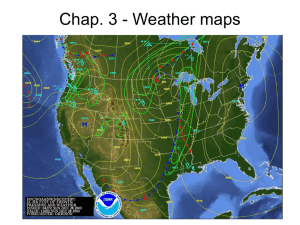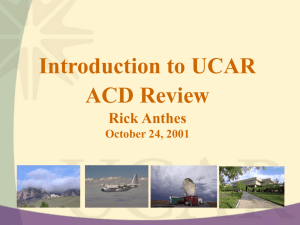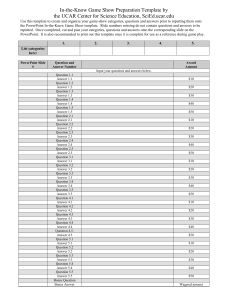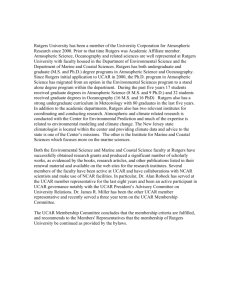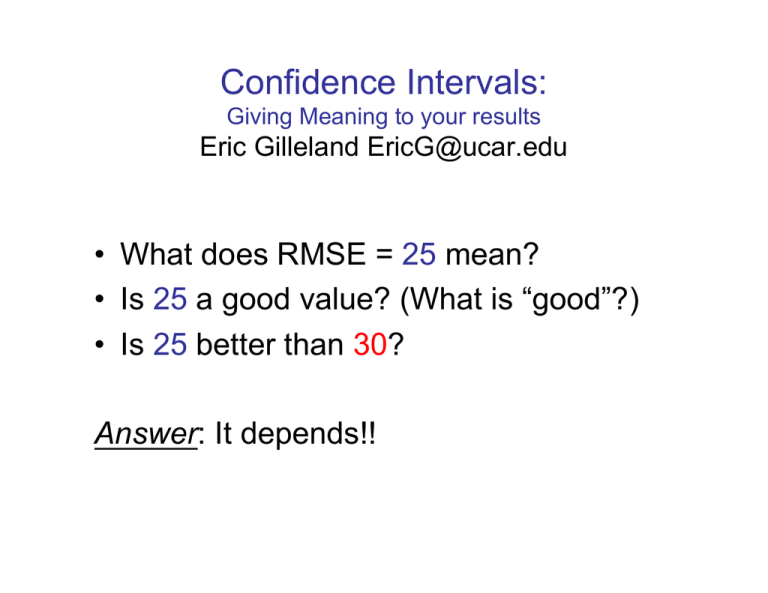
Confidence Intervals:
Giving Meaning to your results
Eric Gilleland EricG@ucar.edu
• What does RMSE = 25 mean?
• Is 25 a good value? (What is “good”?)
• Is 25 better than 30?
Answer: It depends!!
)
copyright 2009, UCAR, all rights
reserved.
)
copyright 2009, UCAR, all rights
reserved.
Accounting for Uncertainty
• Observational
• Model
– Model parameters
– Physics
• Sampling
– Verification statistic is a realization of a random
process
– What if the experiment were re-run under identical
conditions?
copyright 2009, UCAR, all rights
reserved.
Hypothesis Testing and
Confidence Intervals
• Hypothesis testing
– Given a null hypothesis (e.g., “Model forecast is un-biased”),
is there enough evidence to reject it?
– Can be One- or two-sided
– Test is against a single null hypothesis.
• Confidence intervals
– Related to hypothesis tests, but more useful.
– How confident are we that the true value of the statistic (e.g.,
bias) is different from a particular value?
copyright 2009, UCAR, all rights
reserved.
Hypothesis Testing and
Confidence Intervals
Example: The difference in bias between
two models is 0.01.
Hypothesis test: Is this different from
zero?
Confidence interval: Does zero fall within
the interval? Does 0.5 fall within the
interval?
copyright 2009, UCAR, all rights
reserved.
Confidence Intervals (CI’s)
“If we re-run the experiment 100
times, and create 100 (1-α)100%
CI’s, then we expect the true
value of the parameter to fall
inside (1-α)100 of the intervals.”
Example: 95% CI has α=0.05, and
it is expected that 95 of the 100
intervals would contain the true
parameter.
copyright 2009, UCAR, all rights
reserved.
Confidence Intervals (CI’s)
• Parametric
– Assume the observed sample is a realization from
a known population distribution with possibly
unknown parameters.
– Normal approximation CI’s are most common.
– Quick and easy.
copyright 2009, UCAR, all rights
reserved.
Confidence Intervals (CI’s)
• Nonparametric
– Assume the distribution of the observed sample is
representative of the population distribution.
– Bootstrap CI’s are most common.
– Can be computationally intensive, but easy
enough.
copyright 2009, UCAR, all rights
reserved.
Normal Approximation CI’s
Estimate
Standard normal
variate
copyright 2009, UCAR, all rights
reserved.
(Estimated)
standard error of
true parameter
Normal Approximation CI’s
Example: Let
be an independent
and identically distributed (iid) sample from a
normal distribution with variance
.
Then,
is an estimate of the mean
of the population. A (1-α)100% CI for the mean
is given by
copyright 2009, UCAR, all rights
reserved.
Note: You can find
much more about these
ideas in any basic
statistics text book
Normal Approximation CI’s
• Numerous verification statistics can take
this approximation in some form or another
– Alternative CIs are available for other types of
variables
• Examples: forecast/observation variance, linear
correlation
• Still relies on the underlying sample’s being iid
normal.
• Many contingency table verification scores
also have normal approximation CI’s
(for large enough sample sizes)
– Examples: POD, FAR
copyright 2009, UCAR, all rights
reserved.
Application of Normal Approximation CI’s
• Independence assumption (i.e., “iid”) – temporal and spatial
– Should check the validity of the independence assumption.
– Methods exist that can take into account dependencies.
• Normal distribution assumption
– Should check validity of the normal distribution (e.g., qq-plots).
• Multiple testing
– When computing many confidence intervals, the true significance
levels are affected (reduced) by the number of tests that are done.
– Similar with confidence intervals: point-by-point intervals versus
simultaneous intervals.
copyright 2009, UCAR, all rights reserved.
Simulation Example
Mean Error
Frequency Bias
copyright 2009, UCAR, all rights
reserved.
(Nonparametric)
Bootstrap CI’s
IID Bootstrap Algorithm
1. Resample with replacement from the sample,
,
2. Calculate the verification statistic(s) of interest, say
θ, from the resample in step 1,
3. Repeat steps 1 and 2 many times, say B times, to
obtain a sample of the verification statistic(s),
4. Estimate (1-α)100% CI’s from the sample in step 3.
copyright 2009, UCAR, all rights reserved.
Empirical Distribution (Histogram) of
statistic calculated on repeated samples
Bounds for
90% CI
5%
5%
copyright 2009, UCAR, all rights reserved.
Values of statistic θ
Bootstrap CI’s
IID Bootstrap Algorithm: Types of CI’s
1. Percentile Method CI’s
2. Bias-corrected and adjusted (BCa)
3. ABC
4. Basic bootstrap CI’s
5. Normal approximation
6. Bootstrap-t
copyright 2009, UCAR, all rights
reserved.
Simulation Example
copyright 2009, UCAR, all rights
reserved.
Simulation Example (95% CI’s)
Normal Approximation
Bootstrap (BCa)
Mean Error (0.79)
(0.30, 1.28)
Mean Error (0.79)
(0.30, 1.24)
Frequency Bias (1.60)
(1.02, 2.18)
Frequency Bias (1.60)
(1.21,2.20)
copyright 2009, UCAR, all rights
reserved.
Bootstrap CI’s
Sample size
Use same sample size as the original
sample
– Sometimes better to take
smaller samples (e.g.,
heavy-tailed distributions;
see Gilleland, 2008).
copyright 2009, UCAR, all rights
reserved.
Effect of Dependence
copyright 2009, UCAR, all rights
reserved.
Effect of Dependence (95% CI’s)
Mean = -0.17
Normal CI
(-0.27, -0.06)
Bootstrap CI (BCa)
(-0.27, -0.06)
Normal CI
(w/ variance inflation)*
(-0.47, 0.14)
Bootstrap CI (block)**
(-0.47, 0.11)
*See Gilleland (2010a), sec. 2.11
**sec. 3.4
copyright 2009, UCAR, all rights
reserved.
Bootstrapping in R
booter <- function( d, i) {
A <- verify( d[i, “Observed”], d[i, “Forecast”],
frcst.type=“cont”,
obs.type=“cont”)
return(c( A$MAE, A$ME, A$MSE))
} # end of ‘booter’ function.
Function to compute the statistic(s) of
interest. In this case, MAE, ME and
MSE.
copyright 2009, UCAR, all rights
reserved.
Bootstrapping in R
library( verification)
library( boot)
booted <- boot( Z, booter, 1000)
Load the ‘verification’ and ‘boot’
packages, and use the ‘boot’ function
from this package to resample the data
‘Z’, calculating the statistics via the
‘booter’ function for each of 1000
iterations.
copyright 2009, UCAR, all rights
reserved.
Bootstrapping in R
MAE.ci <- boot.ci( booted, conf=c(0.95, 0.99, 0.999),
type=c(“perc”, “bca”), index=1)
ME.ci <- boot.ci( booted, conf=c(0.95, 0.99, 0.999),
type=c(“perc”, “bca”), index=2)
MSE.ci <- boot.ci( booted, conf=c(0.95, 0.99, 0.999),
type=c(“perc”, “bca”), index=3)
Find the 95-, 99- and 99.9% percentile and BCa
CI’s for each statistic.
copyright 2009, UCAR, all rights
reserved.
Bootstrapping in R
Accounting for dependence
booter.cbb <- function( data) {
A <- verify( data[,”Observed”],
data[,”Forecast”],
frcst.type=“cont”,
obs.type=“cont”)
return( c(A$MAE, A$ME, A$MSE))
} # end of ‘booter.cbb’ function.
Function to calculate the statistic(s)
of interest for a dataset, data. Here
MAE, ME and MSE are calculated.
copyright 2009, UCAR, all rights
reserved.
Bootstrapping in R
Accounting for dependence
booted.cbb <- tsboot( Z, booter.cbb, R=1000,
l=floor( sqrt( dim(Z)[1])),
sim=“fixed”)
Use ‘tsboot’ function to obtain 1000 block
resamples of these statistics using the circular
block bootstrap (CBB) approach (sim=“fixed”).
Use block sizes that are the greatest integer
less than the square root of the length of the
dataset.
copyright 2009, UCAR, all rights
reserved.
Bootstrapping in R
Accounting for dependence
MAE.ci.cbb <- boot.ci( booted.cbb,
conf=c(0.95, 0.99, 0.999),
type=“perc”, index=1)
ME.ci.cbb <- boot.ci( booted.cbb,
conf=c(0.95, 0.99, 0.999),
type=“perc”, index=2)
MSE.ci.cbb <- boot.ci( booted.cbb,
conf=c(0.95, 0.99, 0.999),
type=“perc”, index=3)
Calculate 95-, 99- and 99.9%
CI’s.
copyright 2009, UCAR, all rights
reserved.
Thank you. Questions?
References
Gilleland, E., 2010a: Confidence intervals for
forecast verification. NCAR Technical Note NCAR/
TN-479+STR, 71pp. Available at:
http://nldr.library.ucar.edu/collections/technotes/
asset-000-000-000-846.pdf
Gilleland, E., 2010b: Confidence intervals for
forecast verification: Practical considerations,
(unpublished manuscript, available at: http://
www.ral.ucar.edu/staff/ericg/Gilleland2010.pdf)
copyright 2009, UCAR, all rights
reserved.


